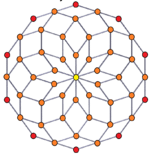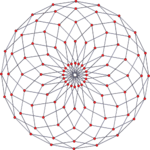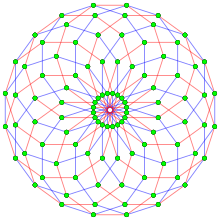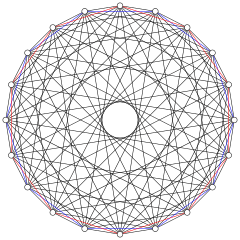10-10 duoprism
In geometry of 4 dimensions, a 10-10 duoprism or decagonal duoprism is a polygonal duoprism, a 4-polytope resulting from the Cartesian product of two decagons.
Uniform 10-10 duoprism Schlegel diagram | |
|---|---|
| Type | Uniform duoprism |
| Schläfli symbol | {10}×{10} = {10}2 |
| Coxeter diagrams | |
| Cells | 25 decagonal prisms |
| Faces | 100 squares, 20 decagons |
| Edges | 200 |
| Vertices | 100 |
| Vertex figure | Tetragonal disphenoid |
| Symmetry | [[10,2,10]] = [20,2+,20], order 800 |
| Dual | 10-10 duopyramid |
| Properties | convex, vertex-uniform, Facet-transitive |
It has 100 vertices, 200 edges, 120 faces (100 squares, and 20 decagons), in 20 decagonal prism cells. It has Coxeter diagram ![]()
![]()
![]()
![]()
![]()
![]()
![]()
Images
The uniform 10-10 duoprism can be constructed from [10]×[10] or [5]×[5] symmetry, order 400 or 100, with extended symmetry doubling these with a 2-fold rotation that maps the two orientations of prisms together.
| 2D orthogonal projection | Net | |
|---|---|---|
 |
 |
 |
| [10] | [20] | |
Related complex polygons

The regular complex polytope 10{4}2, ![]()
![]()
![]()
It also has a lower symmetry construction, ![]()
![]()
![]()
10-10 duopyramid
| 10-10 duopyramid | |
|---|---|
| Type | Uniform dual duopyramid |
| Schläfli symbol | {10}+{10} = 2{10} |
| Coxeter diagrams | |
| Cells | 100 tetragonal disphenoids |
| Faces | 200 isosceles triangles |
| Edges | 120 (100+20) |
| Vertices | 20 (10+10) |
| Symmetry | [[10,2,10]] = [20,2+,20], order 800 |
| Dual | 10-10 duoprism |
| Properties | convex, vertex-uniform, Facet-transitive |
The dual of a 10-10 duoprism is called a 10-10 duopyramid or decagonal duopyramid. It has 100 tetragonal disphenoid cells, 200 triangular faces, 120 edges, and 20 vertices.

Orthogonal projection
Related complex polygon

The regular complex polygon 2{4}10 has 20 vertices in with a real representation in matching the same vertex arrangement of the 10-10 duopyramid. It has 100 2-edges corresponding to the connecting edges of the 10-10 duopyramid, while the 20 edges connecting the two decagons are not included.
The vertices and edges makes a complete bipartite graph with each vertex from one decagon is connected to every vertex on the other.[2]
Related polytopes
The 5-5 duoantiprism is an alternation of the 10-10 duoprism, but is not uniform. It has a highest symmetry construction of order 400 uniquely obtained as a direct alternation of the uniform 10-10 duoprism with an edge length ratio of 0.743 : 1. It has 70 cells composed of 20 pentagonal antiprisms and 50 tetrahedra (as tetragonal disphenoids).

Vertex figure for the 5-5 duoantiprism
See also
- 3-3 duoprism
- 3-4 duoprism
- 5-5 duoprism
- Tesseract (4-4 duoprism)
- Convex regular 4-polytope
- Duocylinder
Notes
- Coxeter, H. S. M.; Regular Complex Polytopes, Cambridge University Press, (1974).
- Regular Complex Polytopes, p.114
References
- Regular Polytopes, H. S. M. Coxeter, Dover Publications, Inc., 1973, New York, p. 124.
- Coxeter, The Beauty of Geometry: Twelve Essays, Dover Publications, 1999, ISBN 978-0-486-40919-1 (Chapter 5: Regular Skew Polyhedra in three and four dimensions and their topological analogues)
- Coxeter, H. S. M. Regular Skew Polyhedra in Three and Four Dimensions. Proc. London Math. Soc. 43, 33-62, 1937.
- John H. Conway, Heidi Burgiel, Chaim Goodman-Strass, The Symmetries of Things 2008, ISBN 978-1-56881-220-5 (Chapter 26)
- Norman Johnson Uniform Polytopes, Manuscript (1991)
- N.W. Johnson: The Theory of Uniform Polytopes and Honeycombs, Ph.D. Dissertation, University of Toronto, 1966
- Catalogue of Convex Polychora, section 6, George Olshevsky.
External links
- The Fourth Dimension Simply Explained—describes duoprisms as "double prisms" and duocylinders as "double cylinders"
- Polygloss - glossary of higher-dimensional terms
- Exploring Hyperspace with the Geometric Product